Project Management Report: Smart Industrial Building Project Analysis
VerifiedAdded on 2022/10/10
|17
|2737
|24
Report
AI Summary
This report analyzes the Smart Industrial Building (SIB) project undertaken by Digital Wise Systems (DWS), a Singaporean SME. The report explores project management concepts, including team formation, project priority matrix development, and cost estimation techniques (top-down vs. bottom-up). It delves into project scheduling using Gantt charts, resource conflict resolution, and the impact of resource allocation on project timelines. The report also examines team development stages based on the five-stage model, specifically addressing conflict resolution strategies within the project team. The report recommends the use of bottom-up estimation and strategies for managing dysfunctional conflict, focusing on the importance of effective project management for successful project completion within budget and schedule constraints.

Running head: PM
Project Management
Name of Student
Name of University
Author Note
Project Management
Name of Student
Name of University
Author Note
Paraphrase This Document
Need a fresh take? Get an instant paraphrase of this document with our AI Paraphraser
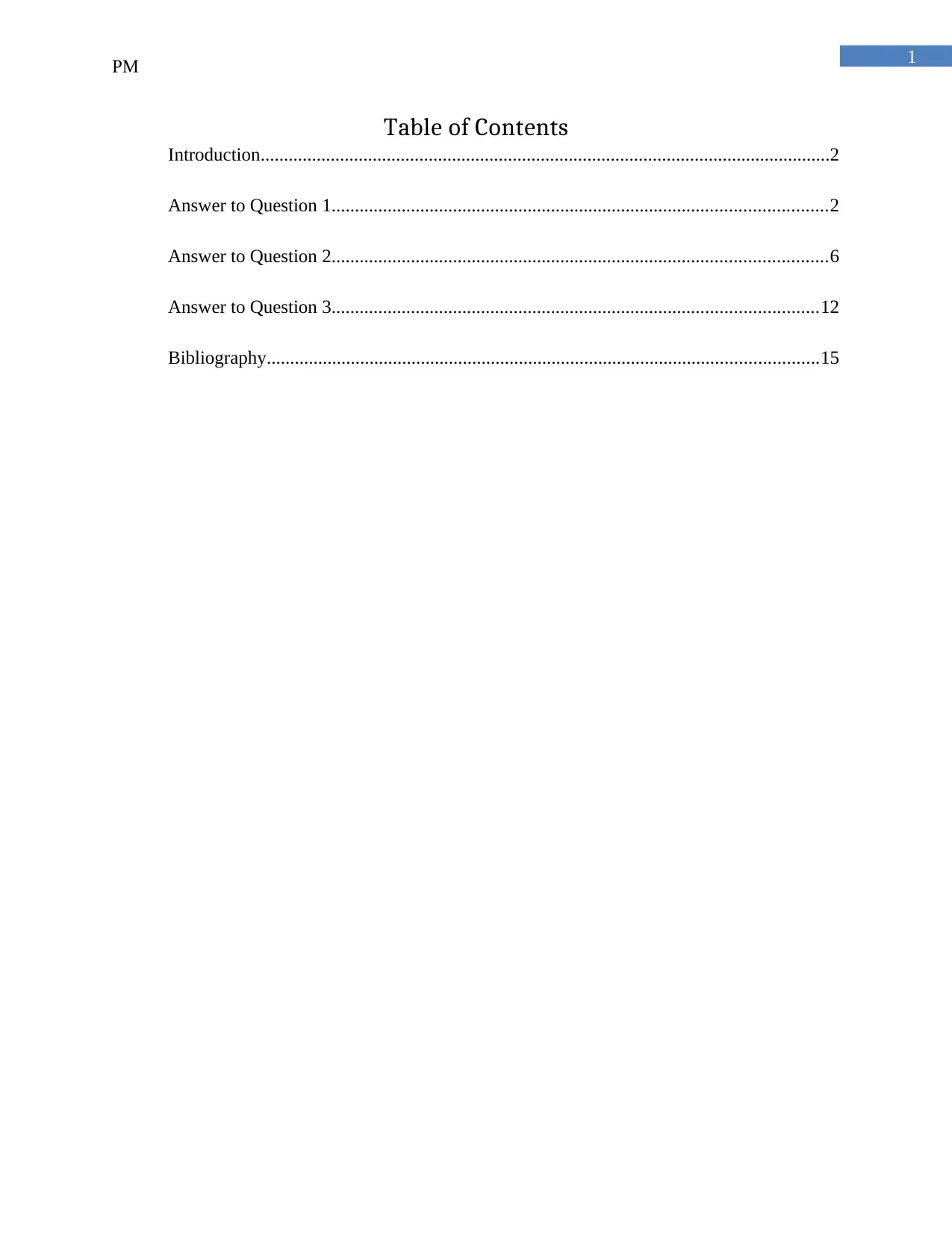
1
PM
Table of Contents
Introduction..........................................................................................................................2
Answer to Question 1..........................................................................................................2
Answer to Question 2..........................................................................................................6
Answer to Question 3........................................................................................................12
Bibliography......................................................................................................................15
PM
Table of Contents
Introduction..........................................................................................................................2
Answer to Question 1..........................................................................................................2
Answer to Question 2..........................................................................................................6
Answer to Question 3........................................................................................................12
Bibliography......................................................................................................................15
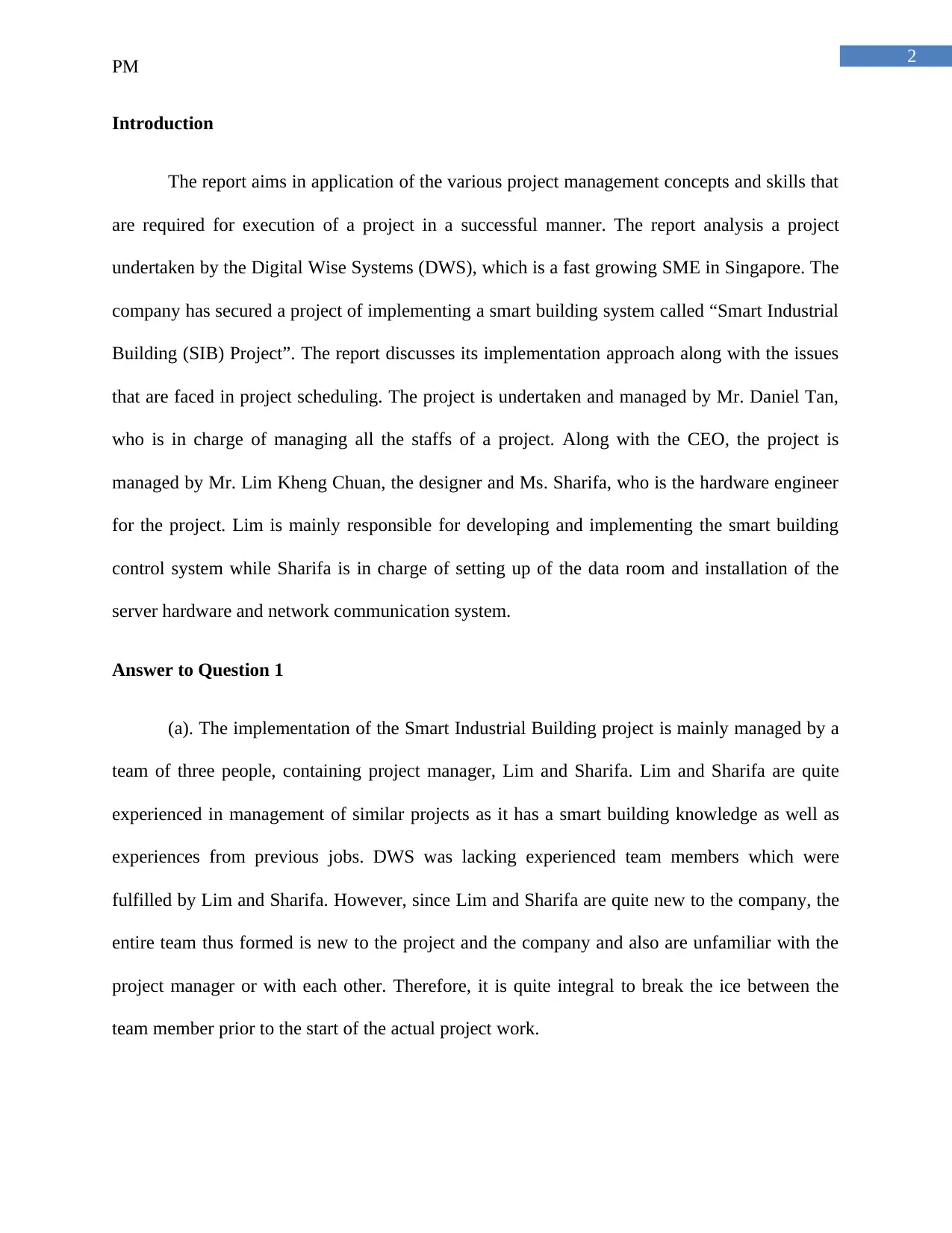
2
PM
Introduction
The report aims in application of the various project management concepts and skills that
are required for execution of a project in a successful manner. The report analysis a project
undertaken by the Digital Wise Systems (DWS), which is a fast growing SME in Singapore. The
company has secured a project of implementing a smart building system called “Smart Industrial
Building (SIB) Project”. The report discusses its implementation approach along with the issues
that are faced in project scheduling. The project is undertaken and managed by Mr. Daniel Tan,
who is in charge of managing all the staffs of a project. Along with the CEO, the project is
managed by Mr. Lim Kheng Chuan, the designer and Ms. Sharifa, who is the hardware engineer
for the project. Lim is mainly responsible for developing and implementing the smart building
control system while Sharifa is in charge of setting up of the data room and installation of the
server hardware and network communication system.
Answer to Question 1
(a). The implementation of the Smart Industrial Building project is mainly managed by a
team of three people, containing project manager, Lim and Sharifa. Lim and Sharifa are quite
experienced in management of similar projects as it has a smart building knowledge as well as
experiences from previous jobs. DWS was lacking experienced team members which were
fulfilled by Lim and Sharifa. However, since Lim and Sharifa are quite new to the company, the
entire team thus formed is new to the project and the company and also are unfamiliar with the
project manager or with each other. Therefore, it is quite integral to break the ice between the
team member prior to the start of the actual project work.
PM
Introduction
The report aims in application of the various project management concepts and skills that
are required for execution of a project in a successful manner. The report analysis a project
undertaken by the Digital Wise Systems (DWS), which is a fast growing SME in Singapore. The
company has secured a project of implementing a smart building system called “Smart Industrial
Building (SIB) Project”. The report discusses its implementation approach along with the issues
that are faced in project scheduling. The project is undertaken and managed by Mr. Daniel Tan,
who is in charge of managing all the staffs of a project. Along with the CEO, the project is
managed by Mr. Lim Kheng Chuan, the designer and Ms. Sharifa, who is the hardware engineer
for the project. Lim is mainly responsible for developing and implementing the smart building
control system while Sharifa is in charge of setting up of the data room and installation of the
server hardware and network communication system.
Answer to Question 1
(a). The implementation of the Smart Industrial Building project is mainly managed by a
team of three people, containing project manager, Lim and Sharifa. Lim and Sharifa are quite
experienced in management of similar projects as it has a smart building knowledge as well as
experiences from previous jobs. DWS was lacking experienced team members which were
fulfilled by Lim and Sharifa. However, since Lim and Sharifa are quite new to the company, the
entire team thus formed is new to the project and the company and also are unfamiliar with the
project manager or with each other. Therefore, it is quite integral to break the ice between the
team member prior to the start of the actual project work.
⊘ This is a preview!⊘
Do you want full access?
Subscribe today to unlock all pages.

Trusted by 1+ million students worldwide
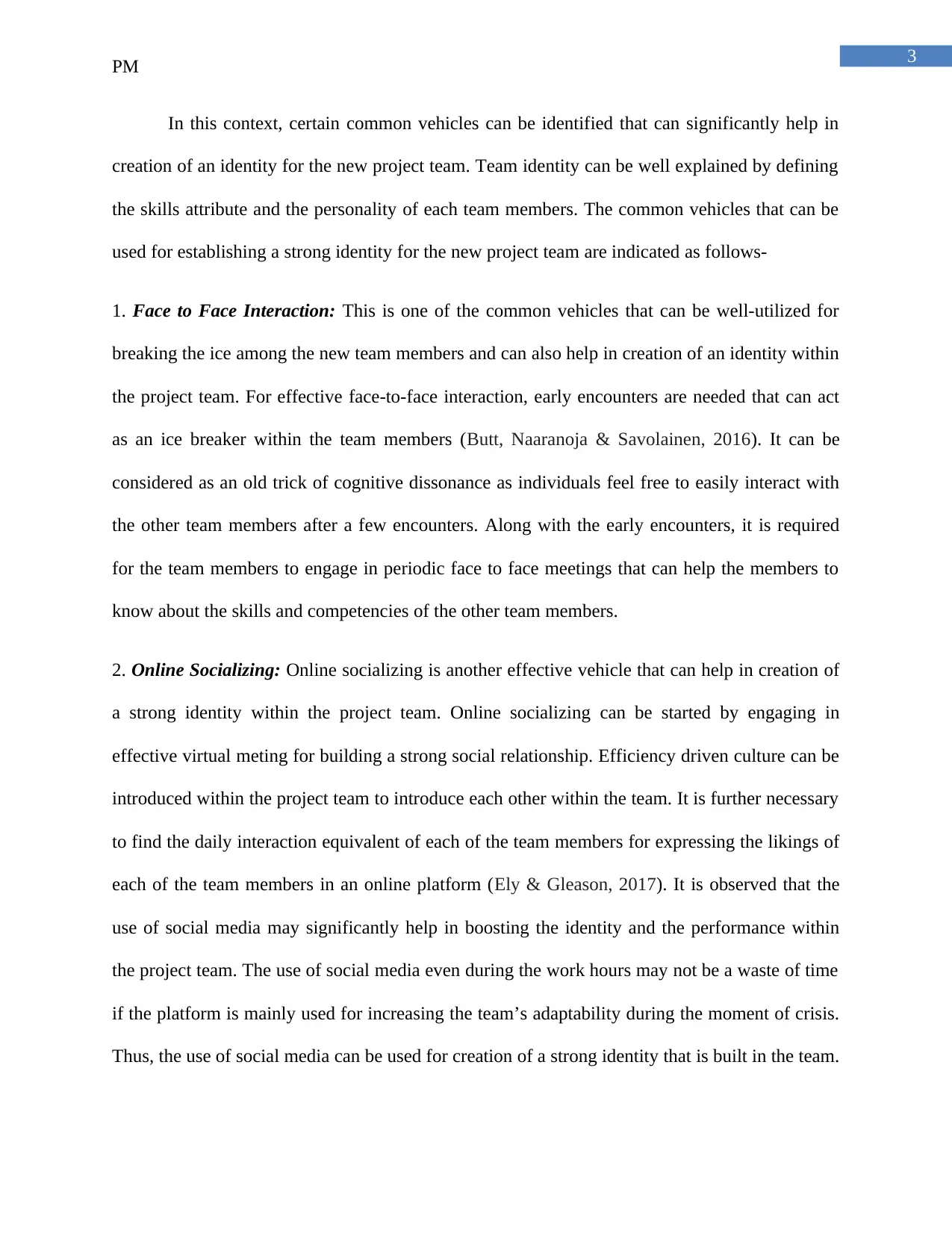
3
PM
In this context, certain common vehicles can be identified that can significantly help in
creation of an identity for the new project team. Team identity can be well explained by defining
the skills attribute and the personality of each team members. The common vehicles that can be
used for establishing a strong identity for the new project team are indicated as follows-
1. Face to Face Interaction: This is one of the common vehicles that can be well-utilized for
breaking the ice among the new team members and can also help in creation of an identity within
the project team. For effective face-to-face interaction, early encounters are needed that can act
as an ice breaker within the team members (Butt, Naaranoja & Savolainen, 2016). It can be
considered as an old trick of cognitive dissonance as individuals feel free to easily interact with
the other team members after a few encounters. Along with the early encounters, it is required
for the team members to engage in periodic face to face meetings that can help the members to
know about the skills and competencies of the other team members.
2. Online Socializing: Online socializing is another effective vehicle that can help in creation of
a strong identity within the project team. Online socializing can be started by engaging in
effective virtual meting for building a strong social relationship. Efficiency driven culture can be
introduced within the project team to introduce each other within the team. It is further necessary
to find the daily interaction equivalent of each of the team members for expressing the likings of
each of the team members in an online platform (Ely & Gleason, 2017). It is observed that the
use of social media may significantly help in boosting the identity and the performance within
the project team. The use of social media even during the work hours may not be a waste of time
if the platform is mainly used for increasing the team’s adaptability during the moment of crisis.
Thus, the use of social media can be used for creation of a strong identity that is built in the team.
PM
In this context, certain common vehicles can be identified that can significantly help in
creation of an identity for the new project team. Team identity can be well explained by defining
the skills attribute and the personality of each team members. The common vehicles that can be
used for establishing a strong identity for the new project team are indicated as follows-
1. Face to Face Interaction: This is one of the common vehicles that can be well-utilized for
breaking the ice among the new team members and can also help in creation of an identity within
the project team. For effective face-to-face interaction, early encounters are needed that can act
as an ice breaker within the team members (Butt, Naaranoja & Savolainen, 2016). It can be
considered as an old trick of cognitive dissonance as individuals feel free to easily interact with
the other team members after a few encounters. Along with the early encounters, it is required
for the team members to engage in periodic face to face meetings that can help the members to
know about the skills and competencies of the other team members.
2. Online Socializing: Online socializing is another effective vehicle that can help in creation of
a strong identity within the project team. Online socializing can be started by engaging in
effective virtual meting for building a strong social relationship. Efficiency driven culture can be
introduced within the project team to introduce each other within the team. It is further necessary
to find the daily interaction equivalent of each of the team members for expressing the likings of
each of the team members in an online platform (Ely & Gleason, 2017). It is observed that the
use of social media may significantly help in boosting the identity and the performance within
the project team. The use of social media even during the work hours may not be a waste of time
if the platform is mainly used for increasing the team’s adaptability during the moment of crisis.
Thus, the use of social media can be used for creation of a strong identity that is built in the team.
Paraphrase This Document
Need a fresh take? Get an instant paraphrase of this document with our AI Paraphraser
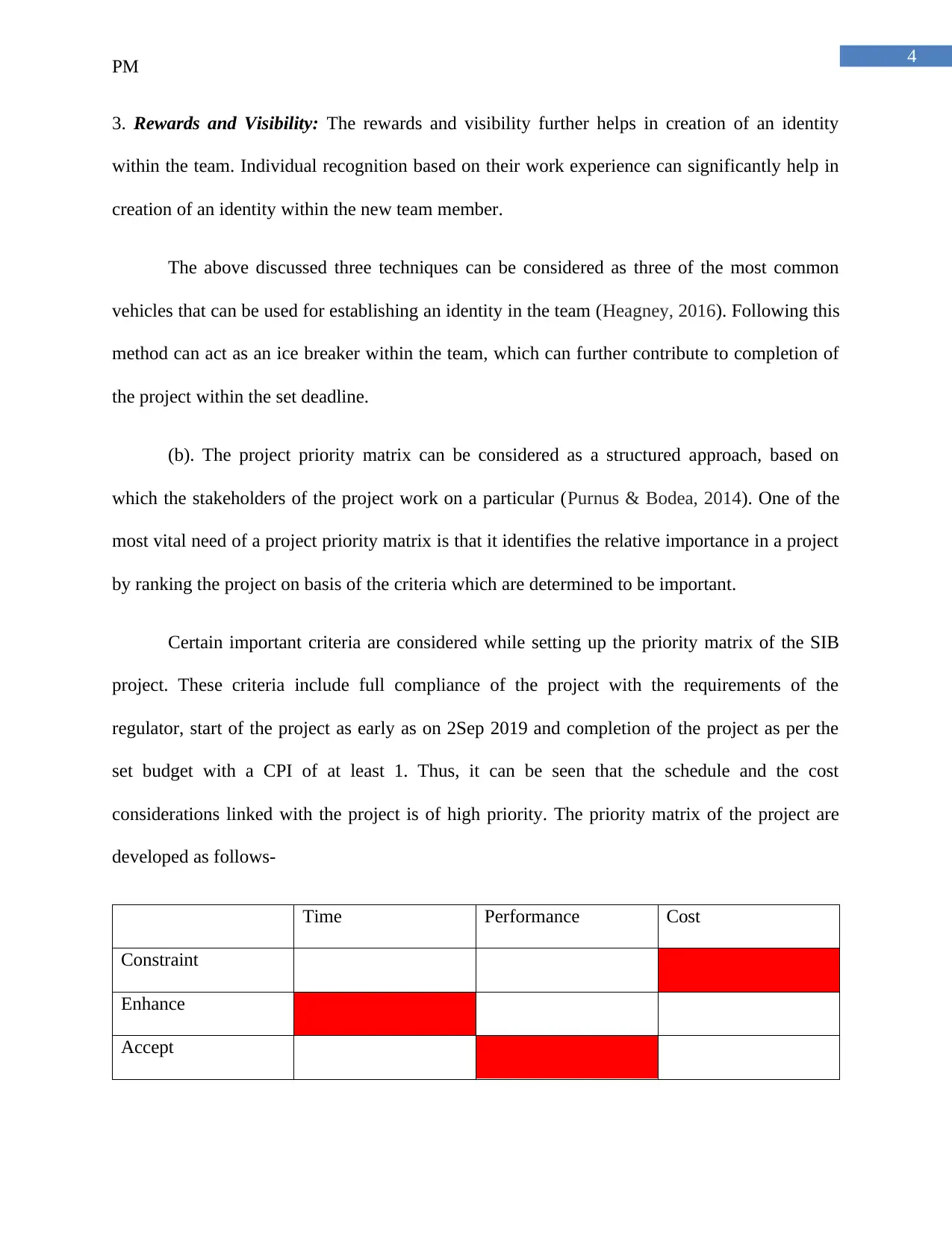
4
PM
3. Rewards and Visibility: The rewards and visibility further helps in creation of an identity
within the team. Individual recognition based on their work experience can significantly help in
creation of an identity within the new team member.
The above discussed three techniques can be considered as three of the most common
vehicles that can be used for establishing an identity in the team (Heagney, 2016). Following this
method can act as an ice breaker within the team, which can further contribute to completion of
the project within the set deadline.
(b). The project priority matrix can be considered as a structured approach, based on
which the stakeholders of the project work on a particular (Purnus & Bodea, 2014). One of the
most vital need of a project priority matrix is that it identifies the relative importance in a project
by ranking the project on basis of the criteria which are determined to be important.
Certain important criteria are considered while setting up the priority matrix of the SIB
project. These criteria include full compliance of the project with the requirements of the
regulator, start of the project as early as on 2Sep 2019 and completion of the project as per the
set budget with a CPI of at least 1. Thus, it can be seen that the schedule and the cost
considerations linked with the project is of high priority. The priority matrix of the project are
developed as follows-
Time Performance Cost
Constraint
Enhance
Accept
PM
3. Rewards and Visibility: The rewards and visibility further helps in creation of an identity
within the team. Individual recognition based on their work experience can significantly help in
creation of an identity within the new team member.
The above discussed three techniques can be considered as three of the most common
vehicles that can be used for establishing an identity in the team (Heagney, 2016). Following this
method can act as an ice breaker within the team, which can further contribute to completion of
the project within the set deadline.
(b). The project priority matrix can be considered as a structured approach, based on
which the stakeholders of the project work on a particular (Purnus & Bodea, 2014). One of the
most vital need of a project priority matrix is that it identifies the relative importance in a project
by ranking the project on basis of the criteria which are determined to be important.
Certain important criteria are considered while setting up the priority matrix of the SIB
project. These criteria include full compliance of the project with the requirements of the
regulator, start of the project as early as on 2Sep 2019 and completion of the project as per the
set budget with a CPI of at least 1. Thus, it can be seen that the schedule and the cost
considerations linked with the project is of high priority. The priority matrix of the project are
developed as follows-
Time Performance Cost
Constraint
Enhance
Accept
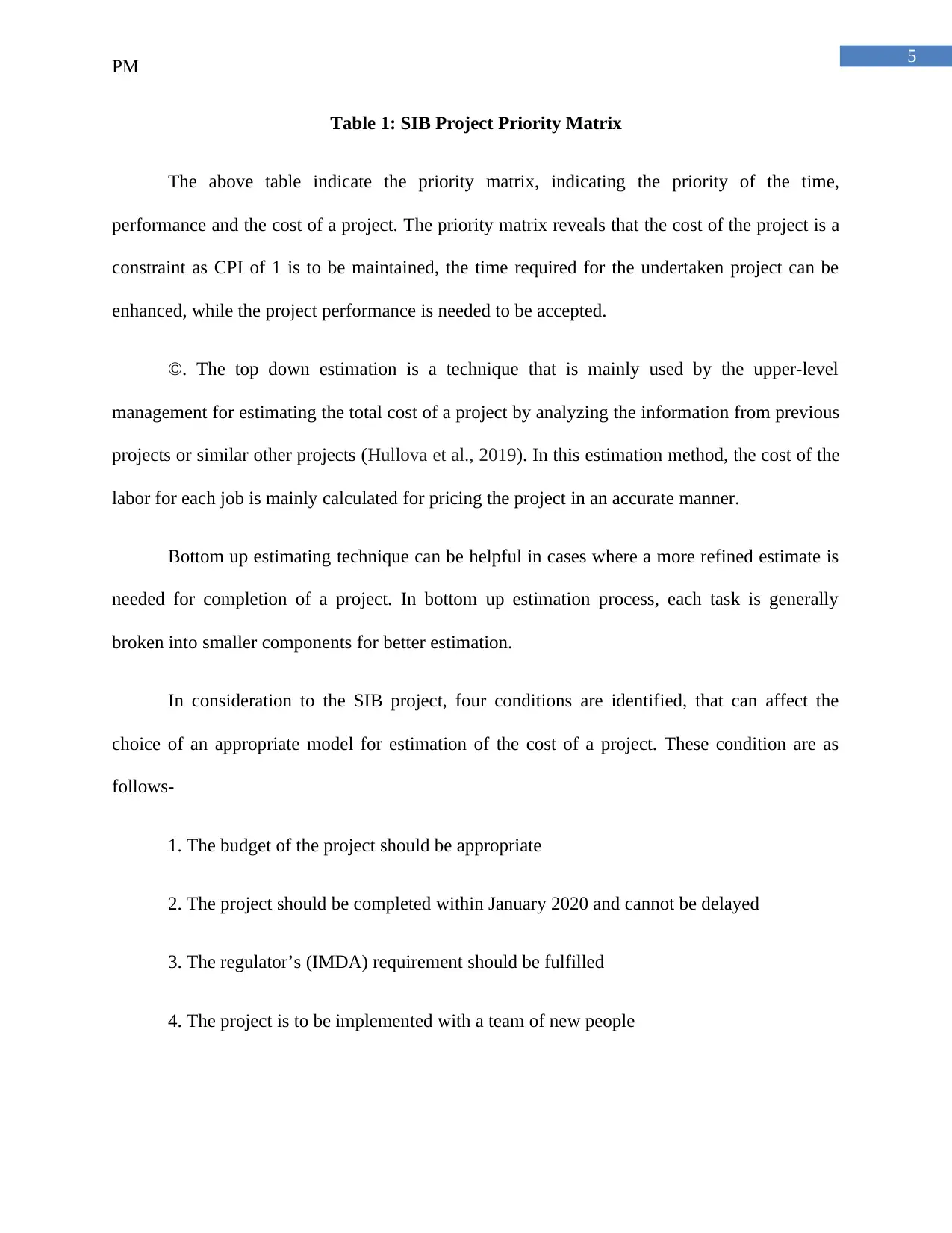
5
PM
Table 1: SIB Project Priority Matrix
The above table indicate the priority matrix, indicating the priority of the time,
performance and the cost of a project. The priority matrix reveals that the cost of the project is a
constraint as CPI of 1 is to be maintained, the time required for the undertaken project can be
enhanced, while the project performance is needed to be accepted.
©. The top down estimation is a technique that is mainly used by the upper-level
management for estimating the total cost of a project by analyzing the information from previous
projects or similar other projects (Hullova et al., 2019). In this estimation method, the cost of the
labor for each job is mainly calculated for pricing the project in an accurate manner.
Bottom up estimating technique can be helpful in cases where a more refined estimate is
needed for completion of a project. In bottom up estimation process, each task is generally
broken into smaller components for better estimation.
In consideration to the SIB project, four conditions are identified, that can affect the
choice of an appropriate model for estimation of the cost of a project. These condition are as
follows-
1. The budget of the project should be appropriate
2. The project should be completed within January 2020 and cannot be delayed
3. The regulator’s (IMDA) requirement should be fulfilled
4. The project is to be implemented with a team of new people
PM
Table 1: SIB Project Priority Matrix
The above table indicate the priority matrix, indicating the priority of the time,
performance and the cost of a project. The priority matrix reveals that the cost of the project is a
constraint as CPI of 1 is to be maintained, the time required for the undertaken project can be
enhanced, while the project performance is needed to be accepted.
©. The top down estimation is a technique that is mainly used by the upper-level
management for estimating the total cost of a project by analyzing the information from previous
projects or similar other projects (Hullova et al., 2019). In this estimation method, the cost of the
labor for each job is mainly calculated for pricing the project in an accurate manner.
Bottom up estimating technique can be helpful in cases where a more refined estimate is
needed for completion of a project. In bottom up estimation process, each task is generally
broken into smaller components for better estimation.
In consideration to the SIB project, four conditions are identified, that can affect the
choice of an appropriate model for estimation of the cost of a project. These condition are as
follows-
1. The budget of the project should be appropriate
2. The project should be completed within January 2020 and cannot be delayed
3. The regulator’s (IMDA) requirement should be fulfilled
4. The project is to be implemented with a team of new people
⊘ This is a preview!⊘
Do you want full access?
Subscribe today to unlock all pages.

Trusted by 1+ million students worldwide
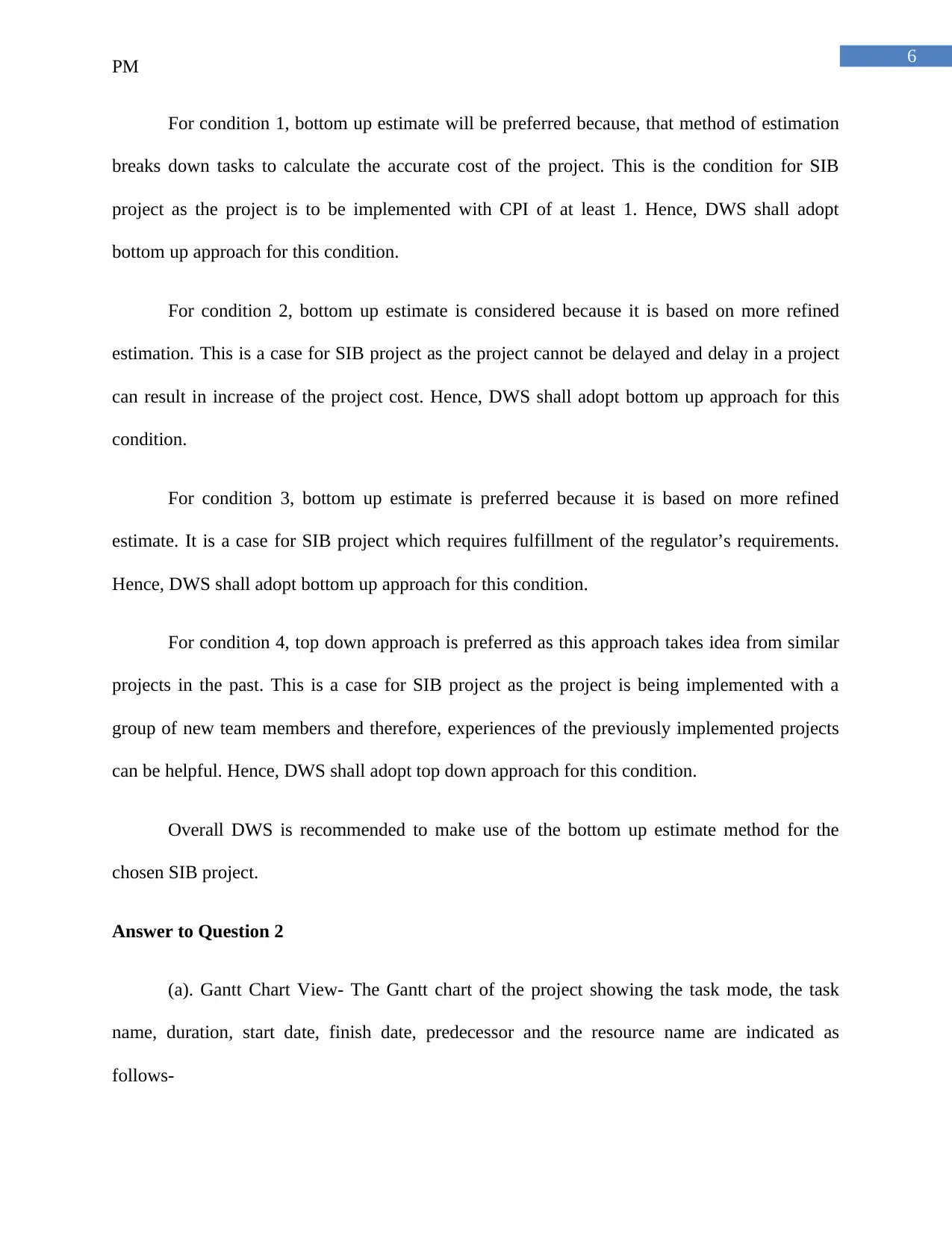
6
PM
For condition 1, bottom up estimate will be preferred because, that method of estimation
breaks down tasks to calculate the accurate cost of the project. This is the condition for SIB
project as the project is to be implemented with CPI of at least 1. Hence, DWS shall adopt
bottom up approach for this condition.
For condition 2, bottom up estimate is considered because it is based on more refined
estimation. This is a case for SIB project as the project cannot be delayed and delay in a project
can result in increase of the project cost. Hence, DWS shall adopt bottom up approach for this
condition.
For condition 3, bottom up estimate is preferred because it is based on more refined
estimate. It is a case for SIB project which requires fulfillment of the regulator’s requirements.
Hence, DWS shall adopt bottom up approach for this condition.
For condition 4, top down approach is preferred as this approach takes idea from similar
projects in the past. This is a case for SIB project as the project is being implemented with a
group of new team members and therefore, experiences of the previously implemented projects
can be helpful. Hence, DWS shall adopt top down approach for this condition.
Overall DWS is recommended to make use of the bottom up estimate method for the
chosen SIB project.
Answer to Question 2
(a). Gantt Chart View- The Gantt chart of the project showing the task mode, the task
name, duration, start date, finish date, predecessor and the resource name are indicated as
follows-
PM
For condition 1, bottom up estimate will be preferred because, that method of estimation
breaks down tasks to calculate the accurate cost of the project. This is the condition for SIB
project as the project is to be implemented with CPI of at least 1. Hence, DWS shall adopt
bottom up approach for this condition.
For condition 2, bottom up estimate is considered because it is based on more refined
estimation. This is a case for SIB project as the project cannot be delayed and delay in a project
can result in increase of the project cost. Hence, DWS shall adopt bottom up approach for this
condition.
For condition 3, bottom up estimate is preferred because it is based on more refined
estimate. It is a case for SIB project which requires fulfillment of the regulator’s requirements.
Hence, DWS shall adopt bottom up approach for this condition.
For condition 4, top down approach is preferred as this approach takes idea from similar
projects in the past. This is a case for SIB project as the project is being implemented with a
group of new team members and therefore, experiences of the previously implemented projects
can be helpful. Hence, DWS shall adopt top down approach for this condition.
Overall DWS is recommended to make use of the bottom up estimate method for the
chosen SIB project.
Answer to Question 2
(a). Gantt Chart View- The Gantt chart of the project showing the task mode, the task
name, duration, start date, finish date, predecessor and the resource name are indicated as
follows-
Paraphrase This Document
Need a fresh take? Get an instant paraphrase of this document with our AI Paraphraser
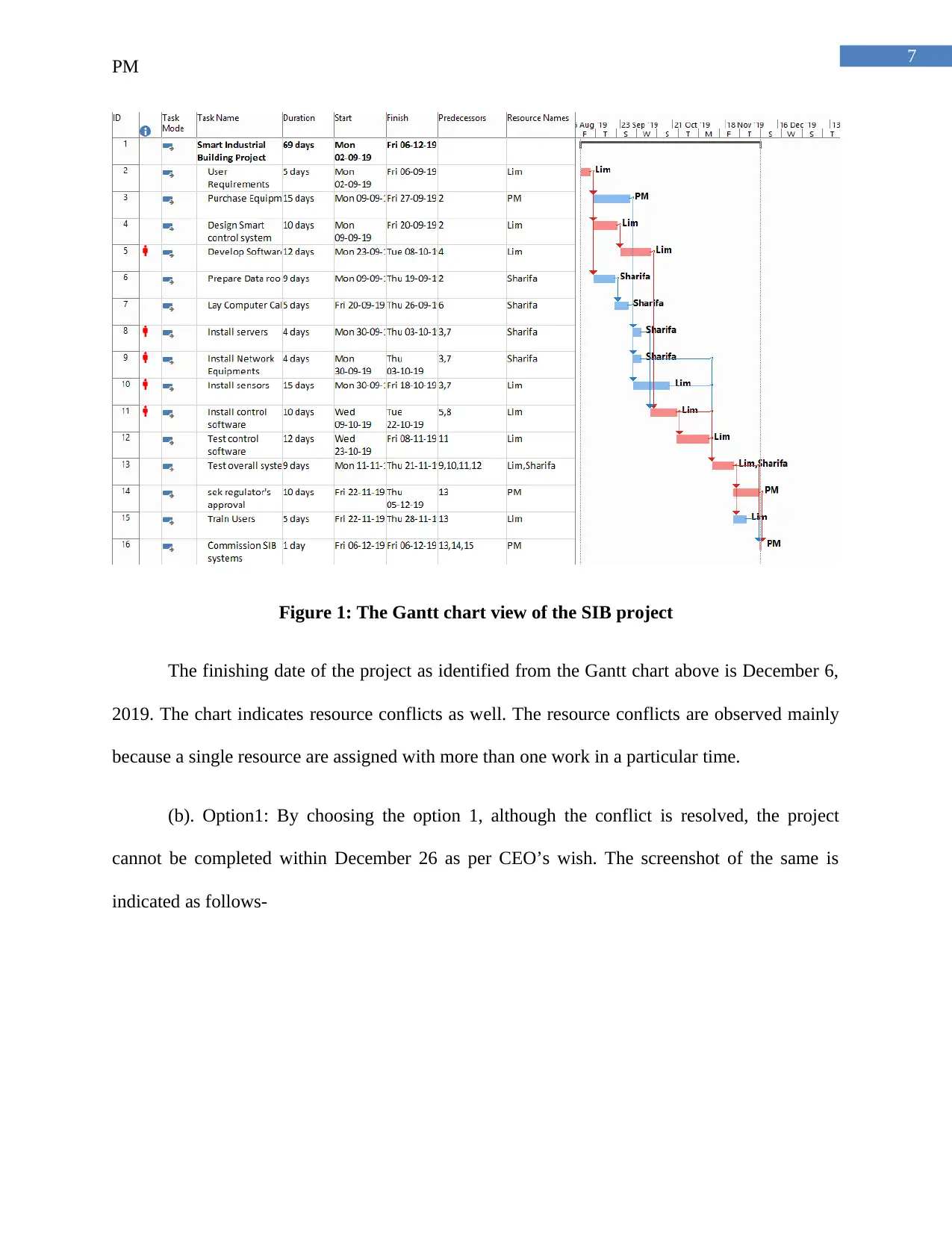
7
PM
Figure 1: The Gantt chart view of the SIB project
The finishing date of the project as identified from the Gantt chart above is December 6,
2019. The chart indicates resource conflicts as well. The resource conflicts are observed mainly
because a single resource are assigned with more than one work in a particular time.
(b). Option1: By choosing the option 1, although the conflict is resolved, the project
cannot be completed within December 26 as per CEO’s wish. The screenshot of the same is
indicated as follows-
PM
Figure 1: The Gantt chart view of the SIB project
The finishing date of the project as identified from the Gantt chart above is December 6,
2019. The chart indicates resource conflicts as well. The resource conflicts are observed mainly
because a single resource are assigned with more than one work in a particular time.
(b). Option1: By choosing the option 1, although the conflict is resolved, the project
cannot be completed within December 26 as per CEO’s wish. The screenshot of the same is
indicated as follows-
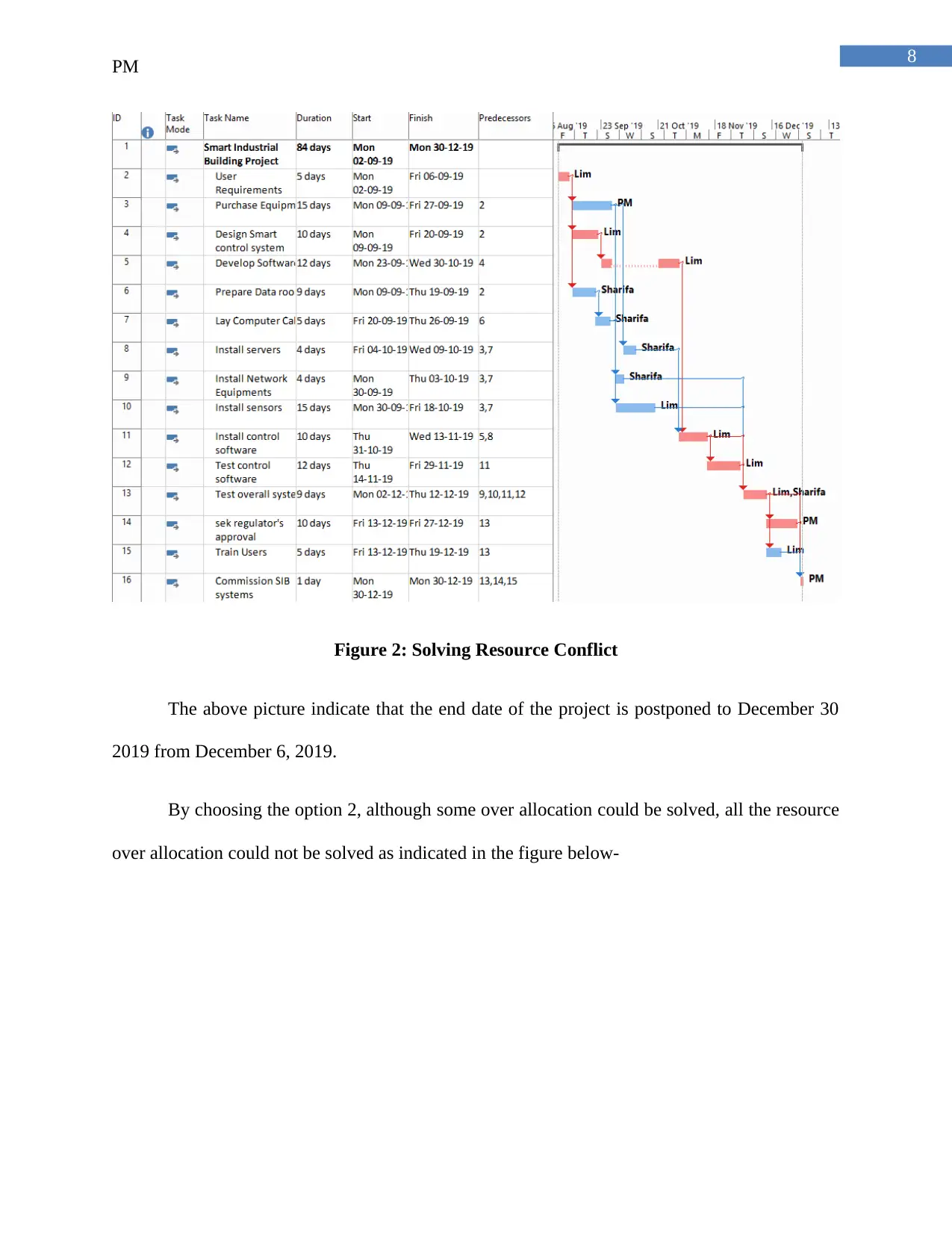
8
PM
Figure 2: Solving Resource Conflict
The above picture indicate that the end date of the project is postponed to December 30
2019 from December 6, 2019.
By choosing the option 2, although some over allocation could be solved, all the resource
over allocation could not be solved as indicated in the figure below-
PM
Figure 2: Solving Resource Conflict
The above picture indicate that the end date of the project is postponed to December 30
2019 from December 6, 2019.
By choosing the option 2, although some over allocation could be solved, all the resource
over allocation could not be solved as indicated in the figure below-
⊘ This is a preview!⊘
Do you want full access?
Subscribe today to unlock all pages.

Trusted by 1+ million students worldwide
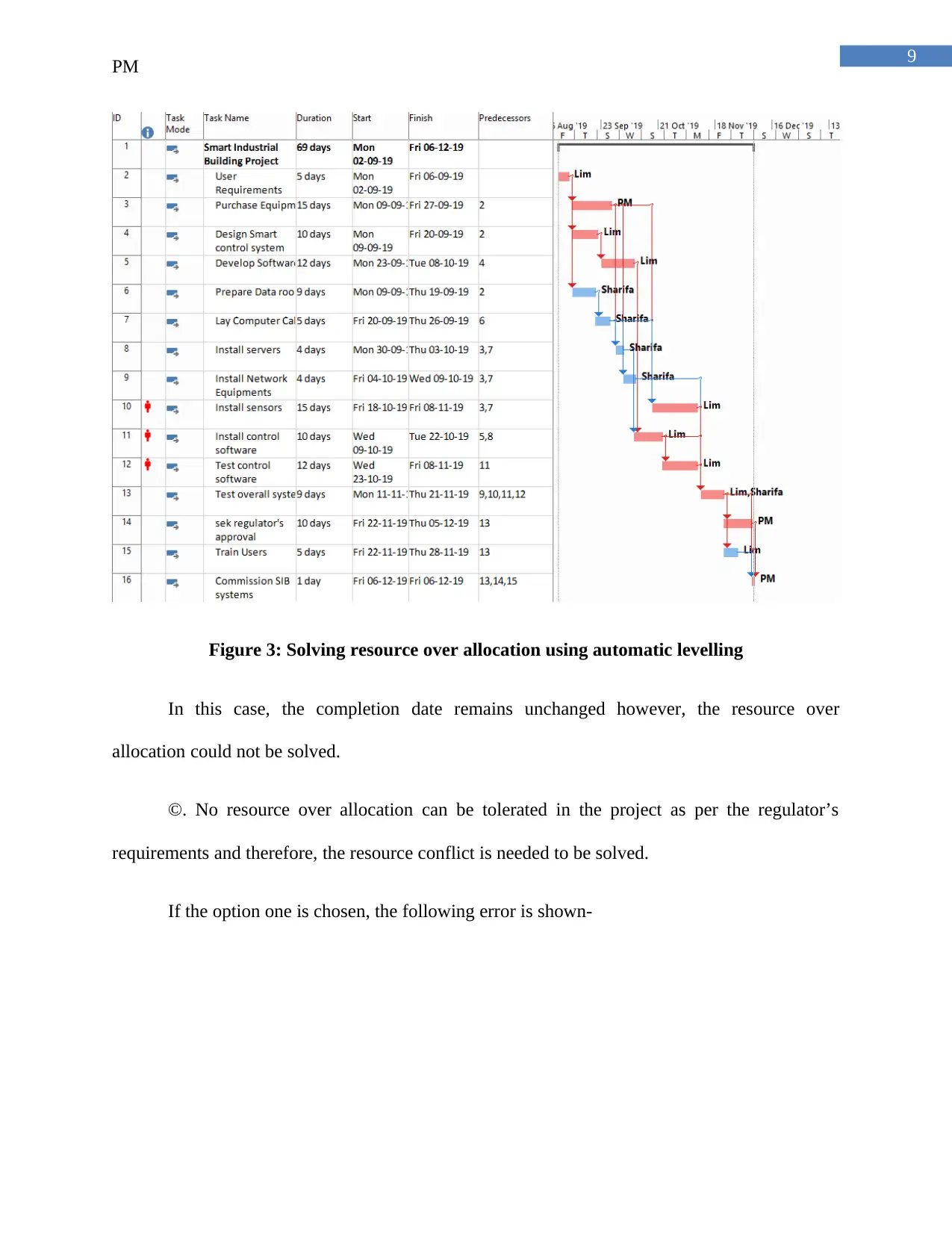
9
PM
Figure 3: Solving resource over allocation using automatic levelling
In this case, the completion date remains unchanged however, the resource over
allocation could not be solved.
©. No resource over allocation can be tolerated in the project as per the regulator’s
requirements and therefore, the resource conflict is needed to be solved.
If the option one is chosen, the following error is shown-
PM
Figure 3: Solving resource over allocation using automatic levelling
In this case, the completion date remains unchanged however, the resource over
allocation could not be solved.
©. No resource over allocation can be tolerated in the project as per the regulator’s
requirements and therefore, the resource conflict is needed to be solved.
If the option one is chosen, the following error is shown-
Paraphrase This Document
Need a fresh take? Get an instant paraphrase of this document with our AI Paraphraser
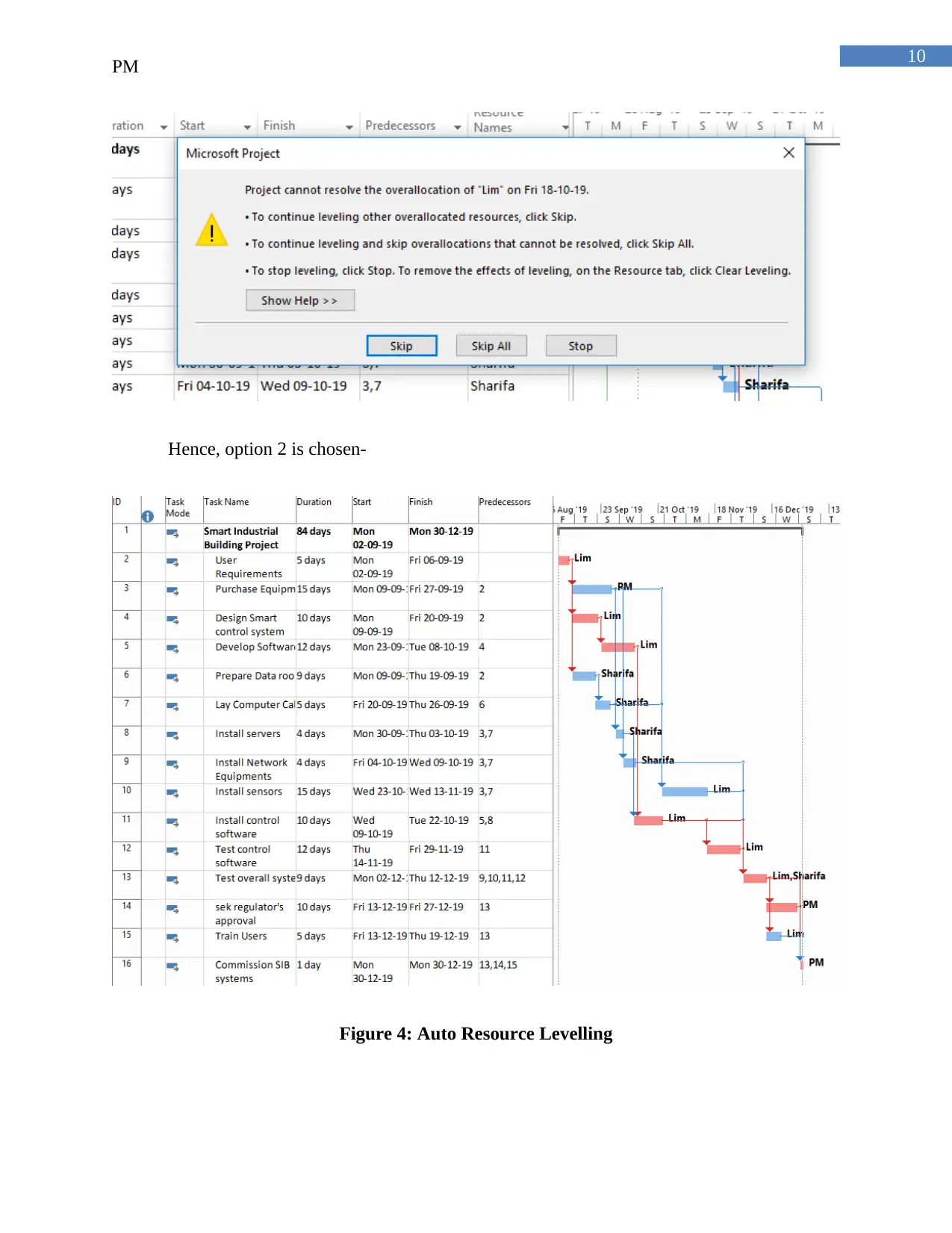
10
PM
Hence, option 2 is chosen-
Figure 4: Auto Resource Levelling
PM
Hence, option 2 is chosen-
Figure 4: Auto Resource Levelling
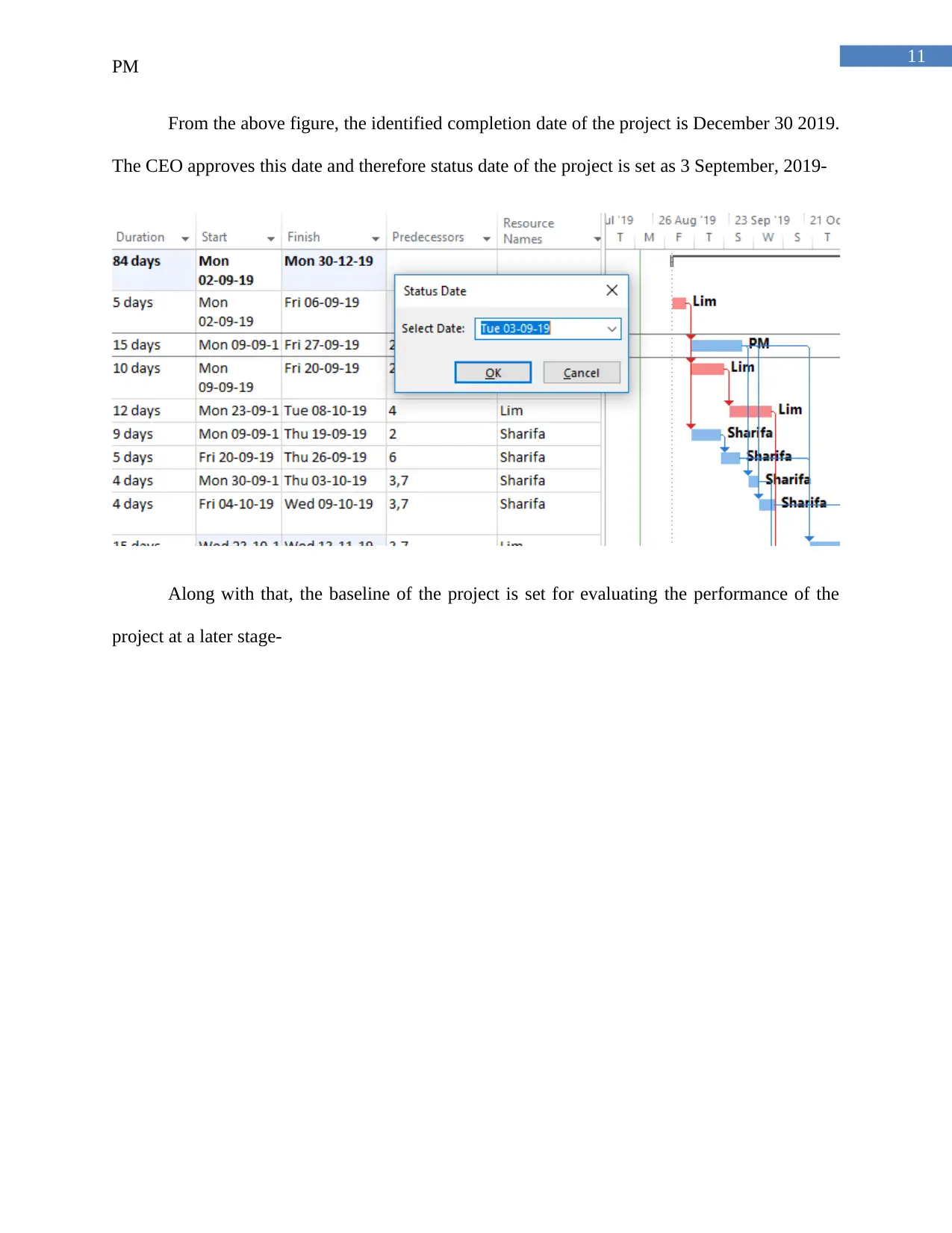
11
PM
From the above figure, the identified completion date of the project is December 30 2019.
The CEO approves this date and therefore status date of the project is set as 3 September, 2019-
Along with that, the baseline of the project is set for evaluating the performance of the
project at a later stage-
PM
From the above figure, the identified completion date of the project is December 30 2019.
The CEO approves this date and therefore status date of the project is set as 3 September, 2019-
Along with that, the baseline of the project is set for evaluating the performance of the
project at a later stage-
⊘ This is a preview!⊘
Do you want full access?
Subscribe today to unlock all pages.

Trusted by 1+ million students worldwide
1 out of 17
Your All-in-One AI-Powered Toolkit for Academic Success.
+13062052269
info@desklib.com
Available 24*7 on WhatsApp / Email
![[object Object]](/_next/static/media/star-bottom.7253800d.svg)
Unlock your academic potential
Copyright © 2020–2025 A2Z Services. All Rights Reserved. Developed and managed by ZUCOL.


